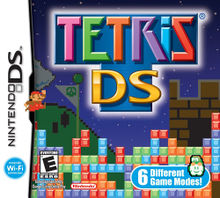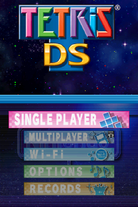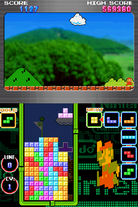Tetris DS: Difference between revisions
No edit summary |
mNo edit summary |
||
| Line 4: | Line 4: | ||
|released = US: March 20, 2006<br>EU: April 21, 2006<br>JP: April 27, 2006 | |released = US: March 20, 2006<br>EU: April 21, 2006<br>JP: April 27, 2006 | ||
|platform = Nintendo DS | |platform = Nintendo DS | ||
|preview = | |preview = 6 | ||
|playfield = | |playfield = 10 × 20 | ||
|hold = | |hold = Yes | ||
|hard = | |hard = Yes | ||
|system = SRS | |system = [[Super Rotation System|SRS]] | ||
|boxart = NDS_Tetris_DS_Box_Front.jpg | |boxart = NDS_Tetris_DS_Box_Front.jpg | ||
|title-scrn=Tetris DS title.png | |title-scrn=Tetris DS title HQ.png | ||
|ingame-scrn=Tetris DS | |ingame-scrn=Tetris DS ingame HQ.png | ||
}} | }} | ||
'''''Tetris DS''''' is a Tetris game for the Nintendo DS published by Nintendo. | '''''Tetris DS''''' is a Tetris game for the Nintendo DS published by Nintendo. | ||
== Gameplay == | |||
'''Tetris DS''' features standard [[Tetris Guideline|Guideline]] rules of gameplay. | |||
==Modes== | ==Modes== | ||
| Line 48: | Line 50: | ||
**double: (Level + Height) * 300 | **double: (Level + Height) * 300 | ||
**triple: (Level + Height) * 500 | **triple: (Level + Height) * 500 | ||
** | **Tetris: (Level + Height) * 800; difficult | ||
**[[twist|T-spin]] no lines ([[Wall kick|kick]]): (Level + Height) * 100 | **[[twist|T-spin]] no lines ([[Wall kick|kick]]): (Level + Height) * 100 | ||
**[[twist|T-spin]] no lines (no kick): (Level + Height) * 400 | **[[twist|T-spin]] no lines (no kick): (Level + Height) * 400 | ||
| Line 56: | Line 58: | ||
**T-spin triple: (Level + Height) * 1600; difficult | **T-spin triple: (Level + Height) * 1600; difficult | ||
**back to back difficult line clears: * 3/2 | **back to back difficult line clears: * 3/2 | ||
***for example, back to back | ***for example, back to back Tetris: (Level + Height) * 1200 | ||
Sources: original research by [[User:Tepples|Tepples]] and [http://tetrisds.moero.info/index.php?����ˡ§ TDS Scoring (Japanese)] | Sources: original research by [[User:Tepples|Tepples]] and [http://tetrisds.moero.info/index.php?����ˡ§ TDS Scoring (Japanese)] | ||
| Line 89: | Line 91: | ||
Modes: | Modes: | ||
*Marathon: complete each mission in the time available or have 5 garbage lines added. | *Marathon: complete each mission in the time available or have 5 garbage lines added. | ||
*Time Trial: choose | *Time Trial: choose difficulties 1 through 5, and complete the set of 10 missions, given in randomized order, as quickly as possible. | ||
===Catch mode=== | ===Catch mode=== | ||
Latest revision as of 08:54, 13 December 2020
| Tetris DS | |
|---|---|
 | |
| Developer(s) | Nintendo |
| Publisher(s) | Nintendo |
| Platform(s) | Nintendo DS |
| Release | US: March 20, 2006 EU: April 21, 2006 JP: April 27, 2006 |
| Gameplay info | |
| Next pieces | 6 |
| Playfield size | 10 × 20 |
| Hold piece | Yes |
| Hard drop | Yes |
| Rotation system | SRS |
Tetris DS is a Tetris game for the Nintendo DS published by Nintendo.
Gameplay
Tetris DS features standard Guideline rules of gameplay.
Modes
Standard mode
Standard Tetris.
This mode supports single player, 2 to 10 player "Ni-Fi" (proprietary local Wi-Fi) with one DS Game Card, and 2 or 4 players in Nintendo Wi-Fi Connection, although many people have found it impossible to get a 4-player game going without it failing with an 86420 error.
In standard versus mode the playfield has 20 visible rows, and at least 23 invisible rows. This can be verified by starting a game against the level 4 or 5 CPU and stacking I, J, L, and T pieces high along the left wall. After doing that, allow the CPU to send you garbage while you play as slowly as possible (allowing pieces to drop slowly, then just as they reach bottom put them in the hold box). It has been confirmed through testing that a filled cell can reach the 43rd row (with the bottom visible row being row 1) without causing a "game over." It is assumed that the player's stack is stored as an array list with no maximum. However it is impossible to verify if a 44th (or higher) row is present because any piece that would reach that height would cause a "game over" when initially placed.
If 1 or both of these conditions is met on either player's screen, the game will end.
- The spawning piece is unable to enter the visible playfield, due to a filled cell being present in row 20 or higher which is in the path of the piece's spawning position.
- A piece has been placed and locked such that the piece is entirely above the visible playfield.
In "marathon" (called A-type in previous products), the player can start on any level from 1 to 20 after having reached that level in a previous game. Whenever the number of lines cleared reaches the level times 10, the level is increased by 1. For example, at level 15, clearing the 150th line changes the level to 16. In "line clear" (called B-type in previous products), the level does not increase.
Like in other games following the Tetris Guideline, gameplay in standard mode rapidly deviates from that of older Tetris games as the level increases because as long as a piece is kept spinning it will not lock (see Infinity). This, combined with the fact that continually spinning pieces have the ability to "climb" over obstacles (see SRS), makes the game almost insultingly easy at fast speeds. Rather than a game where a piece must be maneuvered as it falls, the endgame in standard mode of Tetris DS is "20G": a game where a piece materializes on top of the middle of the stack, and can be moved left or right (while rotating) over small protrusions and positioned as desired.
- ARE
- 0
- DAS
- 11 frames delay, 5 frames period
- Lock delay
- 30 frames
- Line clear delay
- 40 frames
Scoring tables
The scoring in Tetris DS is like that of Tetris Zone.[1]
- Level = as described above, with a maximum of 20
- Height = 0 for Marathon, or chosen height for Line Clear
- Soft drop: 1 point per cell
- Hard drop: 2 points per cell
- Line clears:
- single: (Level + Height) * 100
- double: (Level + Height) * 300
- triple: (Level + Height) * 500
- Tetris: (Level + Height) * 800; difficult
- T-spin no lines (kick): (Level + Height) * 100
- T-spin no lines (no kick): (Level + Height) * 400
- T-spin single (kick): (Level + Height) * 200; difficult
- T-spin single (no kick): (Level + Height) * 800; difficult
- T-spin double: (Level + Height) * 1200; difficult
- T-spin triple: (Level + Height) * 1600; difficult
- back to back difficult line clears: * 3/2
- for example, back to back Tetris: (Level + Height) * 1200
Sources: original research by Tepples and [http://tetrisds.moero.info/index.php?����ˡ§ TDS Scoring (Japanese)]
Push mode
Theme: Donkey Kong
Influences: Original PC prototype of 2-player Tetris [2]
Playfield: 10w x 38h
Push mode starts with two blocks near the center of a playfield roughly twice as tall as the standard playfield. Tetrominoes drop in opposite directions for the two players. Dropping a tetromino past the mass of blocks causes it to disappear. When a player completes more than one line at once, all blocks in the playfield move a number of lines toward the other player's side. (Unlike in Standard mode, T-spins and Back to Backs do not count extra.) Once one block is placed or pushed off a player's end of the playfield, the player loses.
In push mode, it is possible for a game to be drawn by clearing all blocks from the playfield, although the program is incapable of recognizing a drawn game, and the first player to disconnect will lose.
This mode supports single player, 2-player Ni-Fi, and Nintendo Wi-Fi Connection.
Mission mode
Theme: The Legend of Zelda
Missions include
- clear at least 2, 3, or 4 lines with a single tetromino
- clear 2 or 3 lines with any tetromino other than I
- clear 1 or 2 lines with a specified tetromino
- clear 5 lines where only one or two specified tetrominoes are dealt
- clear 5 lines under increased drop speed
- clear 3, 4, or 5 lines using a single type of tetromino
- clear 2 or 3 lines separated by one or two gap rows, otherwise known as a hurdle
- clear a line at a given height on the playfield
- clear a line without rotating tetrominoes, where tetrominoes spawn in random orientations
- clear four lines at a time twice in a row
Conspicuous by their absence are any missions involving T-spins.
Modes:
- Marathon: complete each mission in the time available or have 5 garbage lines added.
- Time Trial: choose difficulties 1 through 5, and complete the set of 10 missions, given in randomized order, as quickly as possible.
Catch mode
Theme: Metroid
Influences: Klustar (GBC) and Katamari Damacy (PS2)
This mode has been compared to inverse Tetris. Player moves and rotates a clump of blocks to catch the falling tetrominoes and avoid the falling metroids. Forming a 4x4 square of blocks without gaps (not necessarily of whole tetrominoes, unlike The New Tetris and Square Tetris mode of Tetris Worlds) will cause the tetrominoes to light up and explode 10 seconds later. The player can add overlapping 4x4 squares to this critical mass within these 10 seconds, or the player can trigger this explosion early. Hitting a falling metroid with the clump, hitting a falling tetromino with the clump while it is rotating, or letting a tetromino hit the bottom, will cause the player to lose health. Colliding with a metroid will also destroy a portion of the clump, and rotating the clump into a falling tetromino will destroy that tetromino. When a cluster of tetrominoes explodes, some health is recovered. When the health bar is depleted, or the clump becomes too large to fit on the screen, the game is over. Although this mode progresses by levels and ends after level 20 like Standard Mode, there is no Endless Mode variant to unlock.
Puzzle mode
Theme: Yoshi's Cookie
Three, four, or five tetrominoes are displayed in the touch screen. The player chooses a tetromino and orientation using either the stylus or the Control Pad and A Button, and if it would clear one or more line, it is dropped into the puzzle in the top screen. (Sliding and in-place spins are not possible.) Goal is to clear all lines.
Alleged design defect: For L, J, and T, which have four distinct orientations, the default orientation is assigned to Left on the Control Pad, not Up as would be expected.
Touch mode
Theme: Balloon Fight
Influence: Klotski; Puzznic
This mode has two modes, one where the blocks drop, and you try to maximize points by shifting and (in levels 1, 2, and 3) rotating tetrominoes and partial tetrominoes to form lines. The other mode "Puzzle" mode, has you attempting to achieve various goals by moving blocks into a certain position to achieve certain numbers of combos, line clears, clear ll blocks. Solutions to the Touch Puzzle Mode can be found here: Tetris DS Touch Solutions
External Links
- Official Tetris Website
- Wikipedia - Wikipedia Article on Tetris DS
- Blockstats - Stat Tracker and Highscore board for Tetris DS
- TDS Gaming Hub - Tetris DS Gaming Hub
| ||||||||||||||

